The Best Water Based Paint Spray Gun — Buyer’s Guide, How-To, Reviews, and Comparison
Possessing impressive grunt combined with dense-medium compatible tips — the best water based paint spray gun machines can knock out the most viscous liquids while still providing fine atomization. Ensuring brushstroke and stipple-free coats, these property improvement units have features that prevent blockages and enable effortless cleaning — ensuring the paint continually runs smoothly. Propelling the waterborne staples of latexes and acrylics, these airless, turbine, and pneumatic power-painters are suitable for any home respray project. Furthermore, with a choice of handheld or external-drive formats — there's a tool for every job scale.
- Pro-grade gun.
- Includes a viscosity cup.
- Backed by Wagner SprayTech.
- Adjustable material flow control.
Best Water Based Paint Spray Gun Information
Water Based Paint Sprayer Comparison Table
| IMAGE | PRODUCT | DETAILS | ||
|---|---|---|---|---|
|
Best External Turbine for Spraying Water-Based Paint
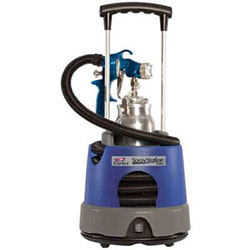
|
Best External Turbine for Spraying Water-Based
Paint
|
Features
|
Check Price at Amazon Earlex HV5500 HVLP Spray Station Review Earlex HV5500 HVLP Spray Station Review | |
|
Best Airless Sprayer for Water-Based Paint 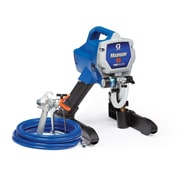
|
Best Airless Sprayer for Water-Based Paint
|
Features
|
Check Price at Amazon Graco Magnum X5 Review Graco Magnum X5 Review | |
|
Best Cordless Water-Based Paint Sprayer 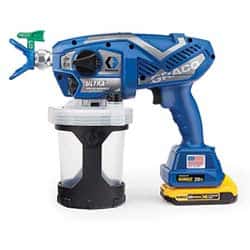
|
Best Cordless Water-Based Paint Sprayer
|
Features
|
Check Price at Amazon Graco 17M363 Review Graco 17M363 Review | |
|
Best Finishing Sprayer for Water-Based Paint 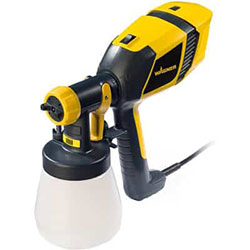
|
Best Finishing Sprayer for Water-Based Paint
|
Features
|
Check Price at Amazon Wagner Control Spray 250 Review Wagner Control Spray 250 Review | |
|
Best Water-Based Sprayer for Walls and Ceilings
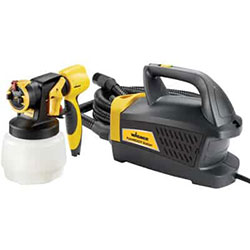
|
Best Water-Based Sprayer for Walls and Ceilings
|
Features
|
Check Price at Amazon Wagner Spraytech PaintReady Review Wagner Spraytech PaintReady Review | |
|
Best Pneumatic Water-Based Paint Sprayer 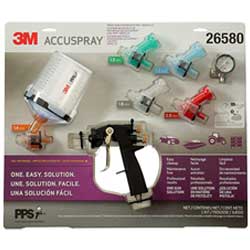
|
Best Pneumatic Water-Based Paint Sprayer
|
Features
|
Check Price at Amazon 3M Accuspray Paint Gun Review 3M Accuspray Paint Gun Review | |
|
Best DIY Sprayer for Water-Based Paint 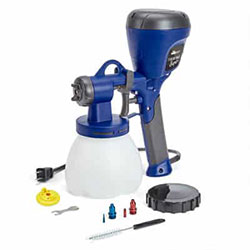
|
Best DIY Sprayer for Water-Based Paint
|
Features
|
Check Price at Amazon HomeRight Super Finish Max C800971 Review HomeRight Super Finish Max C800971 Review | |
|
Best Low Overspray Water-Based Painter 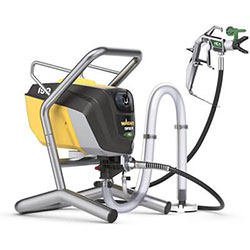
|
Best Low Overspray Water-Based Painter
|
Features
|
Check Price at Amazon Wagner Control Pro 190 Review Wagner Control Pro 190 Review | |
|
Best Cart Water-Based Sprayer 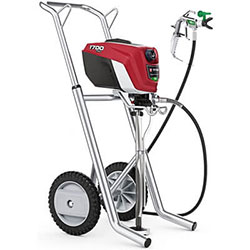
|
Best Cart Water-Based Sprayer
|
Features
|
Check Price at Amazon Titan ControlMax 1700 Pro Review Titan ControlMax 1700 Pro Review |
The Best Water Based Paint Spray Gun Buying Guide
These versatile units rapidly deliver the most commonly used H2O coverage medium formats — faster than both brushes and rollers. And, spraying a fine mist, they ensure your final coat is clean, consistent, and flaw-free.
What Is Water Based Paint?
In broad terms, the noun ‘paint’ refers to every medium that you apply to another surface to give a top coating — whether to change the color, protect from damage, make waterproof, or to add a shine. Hence, this encompasses everything from varnishes and shellacs through to roof-coatings and epoxies.
And, being even more general, this paint consists of two elements — a solute and a solvent.
Look at the wall (or door if your room has wallpaper). That topcoat is the solute, which consists of the dye, latex, binders, polymers, water-repellant, and antifungal chemicals — in fact, whatever are the constituents of your paint type.
You can’t see the solvent — as it has long-since evaporated.
Solvents are what make paints liquid. Without them, your coverage medium would be rock hard, impossible to remove from the can, and unworkable to address onto your target material. Thankfully, as I already mentioned, when they’re exposed to air they evaporate — leaving behind the solute. If they didn’t — all your home surfaces would be permanently wet, which would be impractical and messy, to say the least.
And solvents typically come in two forms — water and oil.
While there are some inconsistencies, contradictions, and exceptions — usually, oil-based paints are the varnishes, shellacs, glosses, and urethanes, whereas water-based paints are latexes, roof-coatings, and acrylics.
Hence, water-based paint is any coating medium that utilizes H2O as its solvent.
Are All Paint Sprayers Water-Based Paint Compatible?
It seems a little incongruous. Water is, well, watery. You think it would happily flow through any size and power of paint sprayer, due to its extremely liquid nature.
But it doesn’t.
This is due to two factors. Firstly, water is a sneaky beast. Sure, it pretends to be slippery and fluid, but in fact, it’s surprisingly high on the friction scale.
Lick a small piece of paper and stick it to the wall (in your head, not in real life — well, unless you really want to). It will remain adhered to the surface until your spittle begins to evaporate (see, solvent again) — and this is due to the friction of the H2O in your oral goo. Hence, this is why car engines use oil as a lubricant and not water. Seriously, don’t try using a bottle of Perrier in your automobile — unless you want to wreck it.
Secondly, the solutes in water-based paint are different from those in oil-based. The dyes, binders, and polymers are significantly more dense than those used in oily mediums — which adds even more viscosity.
These two factors mean that to use water-based paint with a spray gun — you either have to dilute the medium first, or preferably, use a machine capable of propelling this thick liquid.
Why Use a Water Based Paint Sprayer?
Water-based paints are typically utilized on medium-to-large scale projects. Latexes and acrylics are the go-to paints for addressing property walls, ceilings, and fence whitewashes — meaning if you’re using a brush or a roller, it’s going to take a significant amount of effort and a lot of your precious time. Sure, paintbrushes may have their place for small, precise, oil-based stain work — but for expansive waterborne coating projects, you need a spray gun (that said, there are many benefits to using a power sprayer for stains — check out my article on varnishes and shellacs).
Additionally, using a paint gun for water-based paints has the advantages of:
- No brush marks or lost bristles to ruin your final coat.
- Can knock out acrylics, latexes, some epoxies, and stains.
- As they can propel dense paints, most can also double up as thin medium machines for varnishes and lacquers.
- Ten times swifter than a handheld brush.
- Provide a fine spray to produce a flawless, sheer coat.
- Require significantly less physical effort than handheld rollers and brushes.
- Virtually impossible to overload or underload — unlike a paintbrush or roller.
- You have more free time to watch the ball game.
- Can access corners and crevices unreachable by brushes.
- It’s darn fun.
How to Choose the Best Water Based Spray Gun?
While not an exhaustive list, here are the factors that are worthy of consideration when selecting your ideal waterborne power painter.
Power Unit Format
Water-based paint sprayers are available in three formats — HVLP turbines, pneumatic, and airless.
HVLP Turbines
The most affordable, straightforward in operation, and popular sprayers for delivering water-based paints.
Utilizing an internal fan (or series of fans, known as stages), these machines use a high volume of air in conjunction with relatively low pressure to propel the coating medium — hence HVLP.
Requiring little set-up and operational straight-outta-the-box, they’re ideal for DIYers and power painting newbies. Models such as the Earlex HV5500 provide a pleasing finish and low overspray, making them excellent indoor wall and ceiling units.
Pneumatic
However, their lack of portability — they have to be connected to a compressor unit — and their restrictive paint container capacity makes them only suitable for small-scale work.
Airless
Using a powerful hydraulic pump to drive the coating medium, airless machines are the true beasts in waterborne paint spraying.
Units such as the Graco X5 knock out over 3000 PSI — allowing them to propel the most viscous of mediums with seriously fine atomization. This mighty grunt also means rapid coverage — making them excellent large-scale project sprayers.
The downside is that they can be heavy on overspray — fine if you’re addressing outdoor fencing but not ideal if you’re showering your living room with wayward paint.
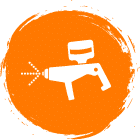
Externally-Driven or Handheld
Handheld units incorporate the pump or turbine into the gun casing. This results in a highly portable and compact machine — typically no larger than a standard drill. Their modest size makes them most suitable for small to medium-scale jobs.
External-drive sprayers feature the power pack located in a floor standing or cart-mounted unit. This allows the machines to have a larger motor — as there are no restrictions on what can comfortably be supported in one hand. Thus, these sprayers with their greater brawn are more applicable to larger project work where rapid coverage is crucial.
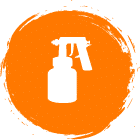
Nozzle
The design and size of the gun nozzle determine the level of atomization, the accuracy of delivery, and the paint viscosity that the sprayer can propel.
As water-based mediums are dense — this requires a larger diameter nozzle than you would utilize for thin fluids such as stains and sealers. Generally speaking, turbine machines need at least a 1.6 mm tip to adequately propel waterborne paints, while airless units, with their greater power output, need a 1.3 mm nozzle.
Since selecting the correct tip is crucial and challenging — as it’s affected by the PSI of the sprayer, liquid viscosity, and airflow volume — I’ve put together a complete guide on choosing the ideal nozzle.
Paint Container Size
This issue can be avoided by using an external-drive airless machine. These sprayers allow you to attach a suction hose to an original paint can — which draws the coating medium directly into the power-painter, without having to carry the paint in your hand.

Mains Cord and Hose Length
Hence, when selecting your perfect water-based paint sprayer, consider the size of your jobs. Addressing outbuildings, external walls, and lengthy border fencing would require more substantial hoses and cord than covering indoor walls.
How to Spray Water Based Paint
However, before you crack on, here are the key items I suggest having ready-to-hand:
What You Will Need to Follow This Tutorial
- A paint sprayer suitable for water-based paint — such as the Earlex HV5500.
- Masking tape and drop-cloths.
- Wooden paint stirrers.
- Waterborne paint ideal for your project — latex, acrylic, epoxy, etc.
- Plastic mixing cup.
- An old bucket.
- Handheld putty knife or paint scraper.
- Sandpaper/ glass paper and/or electric sander.
- Paint conditioner.
- Clean water.
- Wood filler or spackle.
- Heat gun.
- Suitable tip(s) for your paint.
- Sponge, cloth, and warm soapy water.
- Screwdrivers.
- Viscosity cup.
- Digital timer.
- Sugar soap.
- Claw hammer.
- Polythene sheets.
- Overalls.
- Dust mask, safety goggles, and protective gloves.
- Extension cable (if needed).
How to Spray Waterborne Paint
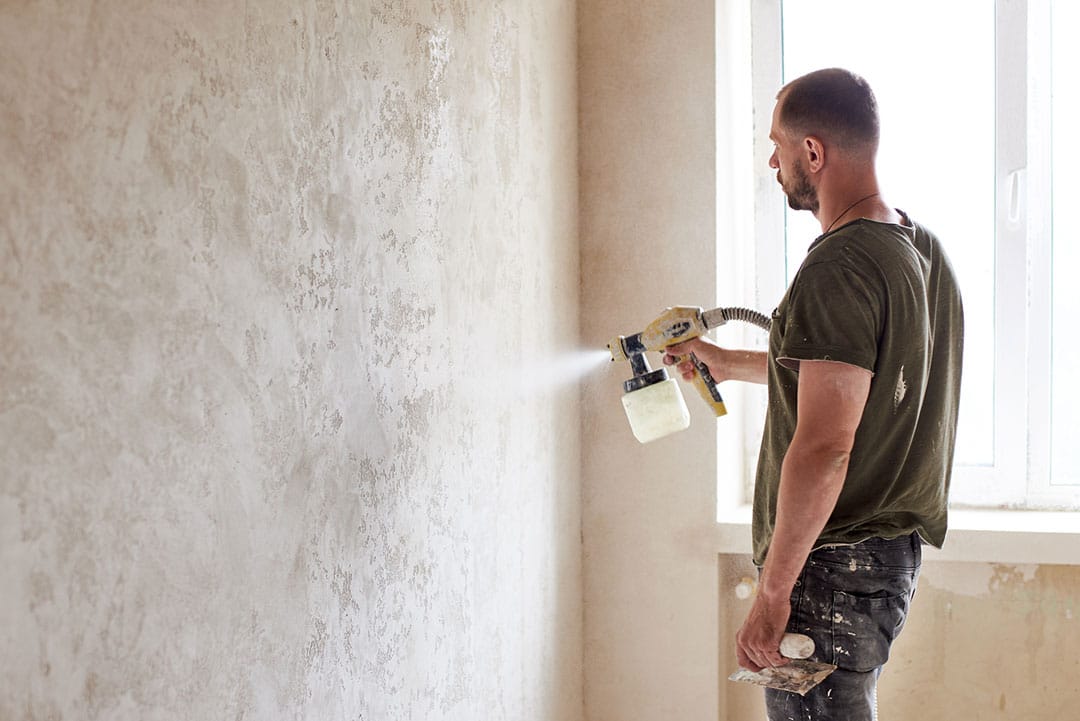
Step 1 — Target Material Preparation
- Kit yourself up in your protective gear.
- If you’re working inside a property, move as much furniture and electrical equipment out of the room as possible. Alternatively, move these items to the center of the room and cover them with drop cloths.
- Protect flooring and carpets around the area to be painted — again, utilize drop cloths or polythene sheeting.
- Use masking tape and old newspapers to protect any areas which do not require coverage.
- Remove any hardware (knockers, handles, etc.) from doors and woodwork using a screwdriver. If you’re addressing walls, either take off electrical sockets and switches or protect with masking tape.
- Inspect woodwork or walls for old tacks, staples, and screws — use a claw hammer to remove.
- You can cover old water-based paint with new water-based paint. However, if you’re mixing mediums — for example, waterborne onto oil — or the existing coat is chipped, scratched, and in generally poor condition, it will need to be removed. Use a heat gun in combination with a putty knife or paint scraper — I’ve compiled a guide on this process here.
Step 2 — Step 2: How To Use Wood Spray Guns With Stain
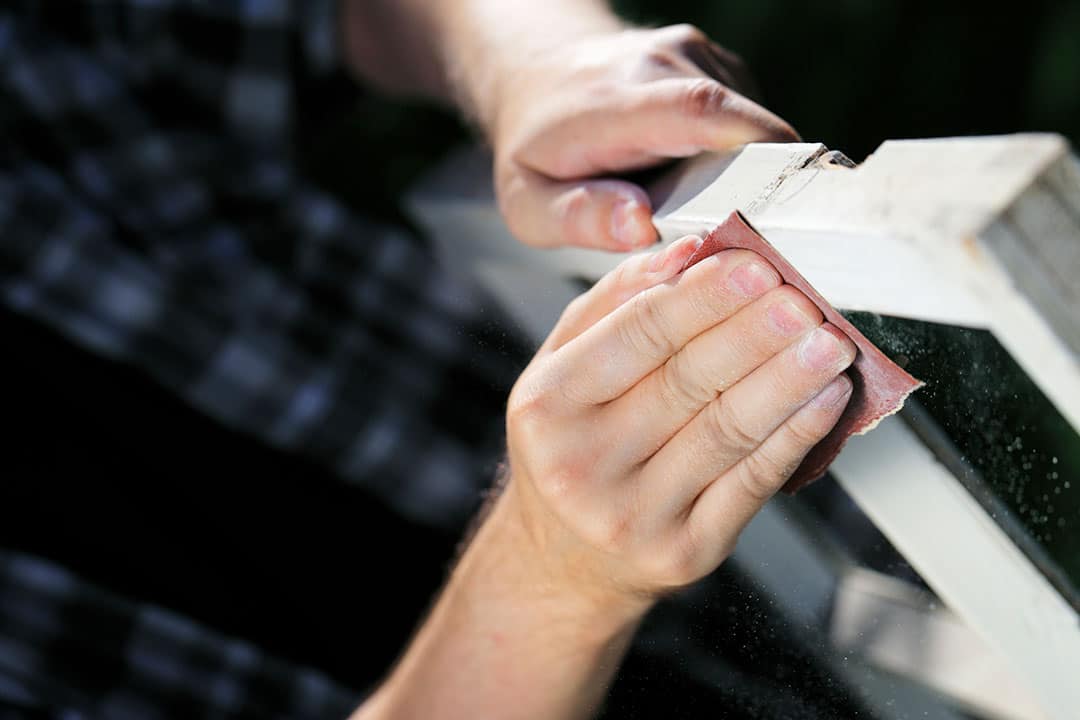
- Use sandpaper or glasspaper to smooth the wood or masonry surface. Start with a coarse grade and then gradually move down to a fine grade. Alternatively, a more rapid method is to use an electric sander.
- Inspect the woodwork, drywall, plaster, or concrete for chips, scratches, and holes. Use either wood filler or spackle to address these areas — allow to dry, and then sand, so it’s flush with the target surface.
- Wash the walls to remove dirt, dust, and detritus with warm soapy water and a sponge. If there are stubborn greasy marks, use sugar soap. Allow to dry thoroughly.
Step 2 — How to Thin Water Based Paint for Spray Gun
Although water-based paint sprayers typically have the power to deliver dense mediums — thinning isn’t always required. However, if you’re using a fine-finishing nozzle, or you simply want to apply a light coat — dilution may be crucial.
Hence, here’s my quick instructions on how to thin water based paint for spraying:
Thinning With a Viscosity Cup
- Fully immerse the viscosity cup into the paint, and then slowly lift it out of the liquid.
- As soon as the medium begins to drain, start your electronic timer.
- Allow the paint to flow freely from the viscosity cup, and stop the timer when it’s empty.
- Refer to your paint sprayer user guide to ascertain the suitable level of density, in conjunction with the viscosity cup reference chart.
- Use clean water to dilute the paint to the desired level — utilizing a plastic mixing cup and wooden stirrer. For more info, I’ve put together a complete guide to paint thinning.
Thinning By Trial and Error
- Dilute your paint with ½ cup of water for every gallon of coating medium.
- Mix together in a mixing cup with a wooden stirrer.
- Place a small amount in your spray gun and perform a test spray. If it’s too thick, add a further ⅛ cup of water and test again. Repeat until the ideal consistency is achieved.
With both methods, always test and adjust the dilution at the same temperature as the medium you’re going to spray. For example, if you’re painting outdoor fencing, thin the paint outside — not in your garage. The ambient heat levels affect how freely coating mediums flow — the warmer the temperature, the more fluid the paint.
Step 3 — Spraying With Water-Based Paint
- If you’re using latex paint — add a little conditioner to the medium to allow the paint to flow easily and deliver a smoother coat.
- Set-up your power painter following the instructions given by the manufacturer. While procedures differ between makes and models, I’ve put together some handy guides on preparing your pneumatic, airless, and turbine machine for use.
- Perform a few initial test sprays into an old bucket — you’re checking to see that the paint is flowing evenly and at the consistency you require. Ideally, your unit should be at the lowest power setting that can suitably propel the medium. Depending on the model, you can adjust airflow and material flow to perfect this delivery.
- Start spraying your target material from a distance of 8-12 inches using long continuous strokes.
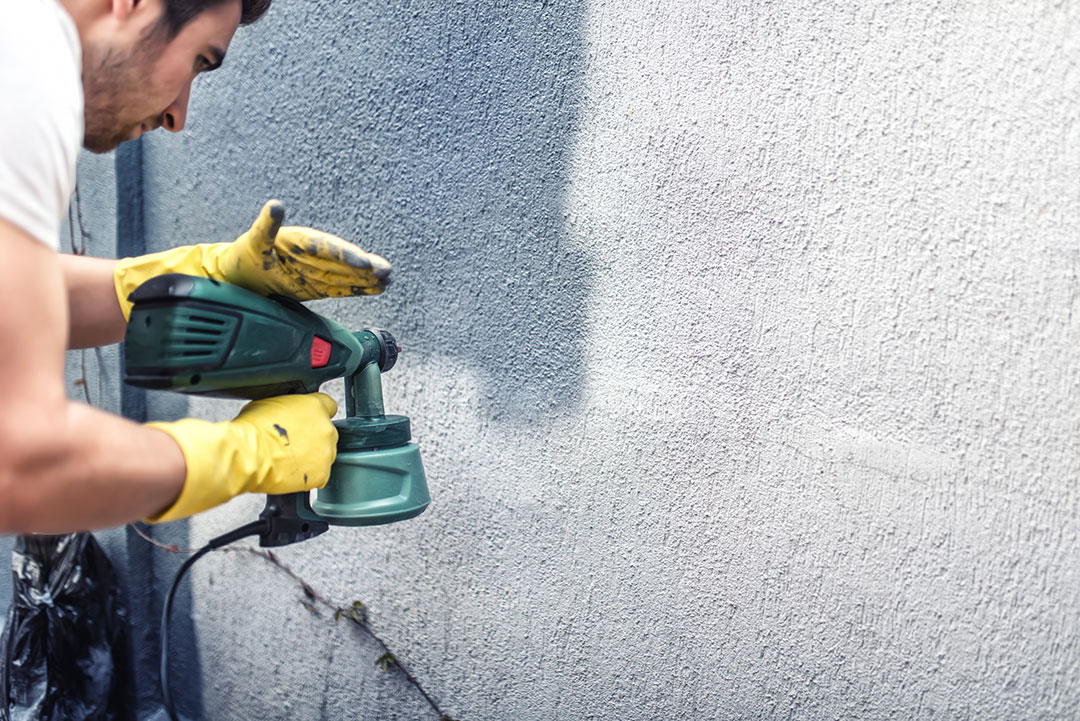
- Match the fan pattern to suit your spraying technique. For up-and-down strokes, as when addressing fence slats, use the horizontal setting. Side-to-side motions, for example on flat walls, require the vertical spray style. And, for corners and areas that require a little finesse, set the unit to the circular pattern.
- Overlap each pass of the paint sprayer by 30-50 percent to ensure complete coverage.
- Allow the paint to dry. In daylight conditions, check the final finish, and, if necessary, give another coat.
- Remove all masking tape and protective coverings from your target material.
- Re-attach any sockets, light switches, or wood hardware that you earlier removed.
- Uncover furniture and flooring — ensuring that no dripped paint on the cloths or sheeting fall onto your carpets.
- Thoroughly clean the sprayer — completely flushing if possible with clean, fresh water. Not only will this extend the longevity of your paint sprayer, but it will also ensure no dried paint rears its head the next time you use the machine.
Our Picks of the Best Spray Gun for Water Based Paint
Boasting a mighty floor-standing two-stage HVLP turbine mounted in a ground-sitting unit, this external-drive machine provides 650-watts of power — making it ideal for more viscous waterborne mediums.
Its lightweight spray gun features a generous stainless steel 2.0 mm tip — allowing it to effortlessly propel thicker paints.
A 1.05-quart container gives sufficient capacity for the majority of small-to-medium scale jobs. Internally coated with PTFE (polytetrafluoroethylene, or Teflon to the rest of us) — it prevents dense paints from sticking to the side of the cup, and allows for headache-free post-project cleaning.
At the heart of this machine is an emphasis on storage and portability. The turbine casing functions as a holder for the gun, cable, and 13-foot hose. Additionally, a high-level carrying handle permits straightforward transportation.
- Comes complete with a viscosity cup for accurate thinning.
- Trade-grade spray gun.
- 5.5-foot power cord.
- Practical storage ability.
- Backed by the paint-spraying behemoth Wagner SprayTech.
- Challenging to store the entire hose in the turbine housing.
- Design
- Functionality
- Price
Boasting a mighty floor-standing two-stage HVLP turbine mounted in a ground-sitting unit, this external-drive machine provides 650-watts of power — making it ideal for more viscous waterborne mediums.
Its lightweight spray gun features a generous stainless steel 2.0 mm tip — allowing it to effortlessly propel thicker paints. And, a straightforward Push-N-Click system enables you to rapidly switch between horizontal, vertical, and circular spray patterns. Furthermore, an easy-turn volume control dial permits you to tailor the medium delivery intensity to suit your base material.
A 1.05-quart container gives sufficient capacity for the majority of small-to-medium scale jobs. Internally coated with PTFE (polytetrafluoroethylene, or Teflon to the rest of us) — it prevents dense paints from sticking to the side of the cup, and allows for headache-free post-project cleaning.
At the heart of this machine is an emphasis on storage and portability. The turbine casing functions as a holder for the gun, cable, and 13-foot hose. Additionally, a high-level carrying handle permits straightforward transportation.
- Comes complete with a viscosity cup for accurate thinning.
- Trade-grade spray gun.
- 5.5-foot power cord.
- Practical storage ability.
- Backed by the paint-spraying behemoth Wagner SprayTech.
- Challenging to store the entire hose in the turbine housing.
- Design
- Functionality
- Price
Ideally suited to medium to large-scale work, the X5 (also marketed as the LTS 15 by Lowe’s), features a 0.5 horsepower pump, knocking out an impressive 3000 PSI. Thus meaning rapid coverage and effortless delivery of dense water-based paints.
The unit arrives complete with the industry-respected metal SG2 gun. Incorporating a 515 tip, it provides fine atomization at a delivery rate of 0.27 GPM (gallons per minute). And, speedy usage requires a ready supply of coating medium, enabled by the suction hose drawing directly from an original can — meaning no paint cup filling requirements.
The shooter connects to the stand-mounted hydraulic pump via a generous 25-foot non-kinking DuraFlex hose. Additionally, should that length be too weedy for your mammoth projects, the powerful brawn of the airless motor can handle up to 75-feet of hose.
In keeping with its pro-DIYer focus, this is a high usage machine for a home unit. Rated for 125 gallons of throughput per year, it’s sufficiently durable to cope with even the most prolific amateur power painter. Furthermore, backed by the mighty Graco brand, access to spare and replaceable parts is made simple by the brand’s extensive catalog of components.
- Skid-mounted for easy operation — no breaking your back reaching for the controls.
- Flush capability permits straightforward cleaning — just connect to a garden hose.
- No paint cup means no refilling.
- Compatible with unthinned waterborne paints.
- Lightweight for an externally-driven hydraulic machine.
- No storage for the gun, hose, or cord.
- A propensity to ‘walk’ due to vibration on the highest pressure setting.
- Design
- Functionality
- Price
Bridging the gap between DIY machines and trade-grade units — this prosumer sprayer is possibly the ultimate water-based airless power-painter.
Ideally suited to medium to large-scale work, the X5 (also marketed as the LTS 15 by Lowe’s), features a 0.5 horsepower pump, knocking out an impressive 3000 PSI. Thus meaning rapid coverage and effortless delivery of dense water-based paints.
The unit arrives complete with the industry-respected metal SG2 gun. Incorporating a 515 tip, it provides fine atomization at a delivery rate of 0.27 GPM (gallons per minute). And, speedy usage requires a ready supply of coating medium, enabled by the suction hose drawing directly from an original can — meaning no paint cup filling requirements.
The shooter connects to the stand-mounted hydraulic pump via a generous 25-foot non-kinking DuraFlex hose. Additionally, should that length be too weedy for your mammoth projects, the powerful brawn of the airless motor can handle up to 75-feet of hose.
In keeping with its pro-DIYer focus, this is a high usage machine for a home unit. Rated for 125 gallons of throughput per year, it’s sufficiently durable to cope with even the most prolific amateur power painter. Furthermore, backed by the mighty Graco brand, access to spare and replaceable parts is made simple by the brand’s extensive catalog of components.
- Skid-mounted for easy operation — no breaking your back reaching for the controls.
- Flush capability permits straightforward cleaning — just connect to a garden hose.
- No paint cup means no refilling.
- Compatible with unthinned waterborne paints.
- Lightweight for an externally-driven hydraulic machine.
- No storage for the gun, hose, or cord.
- A propensity to ‘walk’ due to vibration on the highest pressure setting.
- Design
- Functionality
- Price
Its inbuilt hydraulic airless pump cranks out a modest 500 PSI through to a blistering 2000 PSI, user-adjustable via a side-mounted control dial.
Built for durability, this sprayer features a trade-grade carbide stainless steel piston — ensuring robustness and longevity even with hardcore use, yet still allowing the unit to remain surprisingly lightweight for a grunty machine. Additionally, one-quart disposable FlexLiner bags allow for rapid color switching and straightforward cleaning post-project.
Perhaps the most unique feature of this waterborne medium sprayer is that it’s cordless — unusual in the power painting niche. Driven by a 20-volt DeWalt lithium-ion cell (two included), it allows for one hour of use from a single charge — and arrives complete with a storage case and a battery charger.
- Pro-connect system — allows rapid tool-free pump replacement, reducing downtime.
- Robust spray nozzle guard.
- No cords make the unit highly portable.
- Includes four FlexLiner paint container bags.
- A 60-mesh internal filter protects the pump and ensures a clean coat.
- A premium price for a handheld paint sprayer.
- Could be over-specced for the casual DIY user.
- Design
- Functionality
- Price
Its inbuilt hydraulic airless pump cranks out a modest 500 PSI through to a blistering 2000 PSI, user-adjustable via a side-mounted control dial. Meaning that you can tailor the unit’s output to suit the density of your water-based paints. Furthermore, with a relatively small 514 tip, it promises super-fine atomization for a perfectly smooth coat.
Built for durability, this sprayer features a trade-grade carbide stainless steel piston — ensuring robustness and longevity even with hardcore use, yet still allowing the unit to remain surprisingly lightweight for a grunty machine. Additionally, one-quart disposable FlexLiner bags allow for rapid color switching and straightforward cleaning post-project.
Perhaps the most unique feature of this waterborne medium sprayer is that it’s cordless — unusual in the power painting niche. Driven by a 20-volt DeWalt lithium-ion cell (two included), it allows for one hour of use from a single charge — and arrives complete with a storage case and a battery charger.
- Pro-connect system — allows rapid tool-free pump replacement, reducing downtime.
- Robust spray nozzle guard.
- No cords make the unit highly portable.
- Includes four FlexLiner paint container bags.
- A 60-mesh internal filter protects the pump and ensures a clean coat.
- A premium price for a handheld paint sprayer.
- Could be over-specced for the casual DIY user.
- Design
- Functionality
- Price
A steady throughflow of 1.25 liters per minute provides exceptional control — cutting back on overspray and bounce-back and allowing you to target those areas that demand precision. Furthermore, Wagner’s trademarked Control Finish nozzle promises fine atomization together with a choice of three spray patterns.
A modest 0.84-quart cup keeps weight to a minimum, while allowing for effortless maneuverability on more complex projects. However, despite its relatively small size, it still has sufficient capacity to cover 64 square feet of area.
This waterborne paint sprayer incorporates an industry-standard six-foot mains cord — which should be sufficient for the majority of finishing jobs. And, with Lock-N-Go tech, you can speedily remove the container and nozzle from the turbine housing for effortless cleaning at the end of your working day.
- Backed by Wagner’s extensive warranty.
- Fatigue-busting ergonomic handle.
- Choice of three spray fan patterns.
- Rated for both indoor and outdoor projects.
- Water-based unthinned stain, sealer, and varnish compatible.
- Not suitable for large projects.
- Dense waterborne paints will require some dilution.
- Premium price for a premium product.
- Design
- Functionality
- Price
A steady throughflow of 1.25 liters per minute provides exceptional control — cutting back on overspray and bounce-back and allowing you to target those areas that demand precision. Furthermore, Wagner’s trademarked Control Finish nozzle promises fine atomization together with a choice of three spray patterns.
While able to effortlessly propel unthinned water-based sealers and stains — more dense mediums such as latex and acrylics will require dilution. That said, boasting user-tailorable material flow control — you can adjust the delivery intensity to suit your paint type and the demands of your base material.
A modest 0.84-quart cup keeps weight to a minimum, while allowing for effortless maneuverability on more complex projects. However, despite its relatively small size, it still has sufficient capacity to cover 64 square feet of area.
This waterborne paint sprayer incorporates an industry-standard six-foot mains cord — which should be sufficient for the majority of finishing jobs. And, with Lock-N-Go tech, you can speedily remove the container and nozzle from the turbine housing for effortless cleaning at the end of your working day.
- Backed by Wagner’s extensive warranty.
- Fatigue-busting ergonomic handle.
- Choice of three spray fan patterns.
- Rated for both indoor and outdoor projects.
- Water-based unthinned stain, sealer, and varnish compatible.
- Not suitable for large projects.
- Dense waterborne paints will require some dilution.
- Premium price for a premium product.
- Design
- Functionality
- Price
Its floor-sitting external-drive HVLP turbine keeps the weight of the spray gun to a minimum — relieving fatigue and stress on the arms and hands, especially crucial when completing overhead spraying.
A choice of three spray fan designs enables you to tailor the gun to best suit your target material, while a 15-foot non-kinking hose should permit a complete room repaint without having to relocate the base unit. Furthermore, a propellant rate of 15 fluid ounces per minute ensures that larger jobs can be completed in a timely manner.
This machine incorporates a generous 1.5-quart paint container — one of the largest cups in my top water-based paint sprayer reviews. This allows for 120-square feet of coverage without having to replenish the container. And, with adjustable material flow control, you can set the delivery intensity for a thinner or thicker coat.
- Excellent indoor water-based paint resprayer.
- Incorporated carrying handle increases portability.
- Easy-to-clean turbine housing.
- Can propel unthinned mediums.
- Modern aesthetic.
- Lacks robustness for extended exterior applications.
- Doesn’t feature a fine-finishing head for moldings or corners.
- Design
- Functionality
- Price
Its floor-sitting external-drive HVLP turbine keeps the weight of the spray gun to a minimum — relieving fatigue and stress on the arms and hands, especially crucial when completing overhead spraying.
Featuring Wagner’s versatile iSpray nozzle head, this unit can knock out undiluted waterborne sealers, stains, and latex. And, boasting twin-speed turbine control — you can whack up the output to propel the most viscous of mediums.
A choice of three spray fan designs enables you to tailor the gun to best suit your target material, while a 15-foot non-kinking hose should permit a complete room repaint without having to relocate the base unit. Furthermore, a propellant rate of 15 fluid ounces per minute ensures that larger jobs can be completed in a timely manner.
This machine incorporates a generous 1.5-quart paint container — one of the largest cups in my top water-based paint sprayer reviews. This allows for 120-square feet of coverage without having to replenish the container. And, with adjustable material flow control, you can set the delivery intensity for a thinner or thicker coat.
- Excellent indoor water-based paint resprayer.
- Incorporated carrying handle increases portability.
- Easy-to-clean turbine housing.
- Can propel unthinned mediums.
- Modern aesthetic.
- Lacks robustness for extended exterior applications.
- Doesn’t feature a fine-finishing head for moldings or corners.
- Design
- Functionality
- Price
- Design
- Functionality
- Price
The gun boasts a choice of five interchangeable nozzle tips — 1.2, 1.3, 1.4, 1.8, and 2.0 mm — meaning the shooter can knock out anything from low-viscosity waterborne sealers through to high-density latexes. Furthermore, color-coded for reference, selecting the correct nozzle is effortless.
Additionally, these liners arrive with concomitant lids, enabling you to store any unused paint safely without the risk of the medium drying out. What’s more, a proprietary quarter-turn locking head reduces the chance of cross-threading, paint build-up, and leakage.
A welcome feature is the 360-degree capability of this water-based paint sprayer. Able to deliver mediums from any angle without loss in finish or intensity — even when spraying upside-down — this unit excels at accessing hard-to-reach areas or addressing ceilings.
- A complete pneumatic waterborne paint set.
- HVLP tech combined with five nozzles promise a super-fine finish.
- Lightweight design permits prolonged use.
- Fuss-free cleaning.
- Adjustable spray width feature.
- Doesn’t include a compressor, hose, or hose couplers.
- Disposable lids and liners mean frequent repurchases.
- Design
- Functionality
- Price
The gun boasts a choice of five interchangeable nozzle tips — 1.2, 1.3, 1.4, 1.8, and 2.0 mm — meaning the shooter can knock out anything from low-viscosity waterborne sealers through to high-density latexes. Furthermore, color-coded for reference, selecting the correct nozzle is effortless.
That said, should you wish to thin the paint — this compressor-driven gun makes the process seriously straightforward. Its transparent 0.68-quart paint cup features printed indices — ensuring the perfect dilution. And, including five disposable container liners, switching between paint types and post-job cleaning are fuss-free.
Additionally, these liners arrive with concomitant lids, enabling you to store any unused paint safely without the risk of the medium drying out. What’s more, a proprietary quarter-turn locking head reduces the chance of cross-threading, paint build-up, and leakage.
A welcome feature is the 360-degree capability of this water-based paint sprayer. Able to deliver mediums from any angle without loss in finish or intensity — even when spraying upside-down — this unit excels at accessing hard-to-reach areas or addressing ceilings.
- A complete pneumatic waterborne paint set.
- HVLP tech combined with five nozzles promise a super-fine finish.
- Lightweight design permits prolonged use.
- Fuss-free cleaning.
- Adjustable spray width feature.
- Doesn’t include a compressor, hose, or hose couplers.
- Disposable lids and liners mean frequent repurchases.
- Design
- Functionality
- Price
As a handheld HVLP unit, it’s ideal for addressing modestly-sized jobs such as recovering ceilings or giving walls a fresh coat. Boasting a single-stage 450-watt turbine combined with three brass nozzles — 1.5, 2.0, and 4.0 mm — it can deliver virtually all waterborne mediums with no thinning requirements. What’s more, these tips are color-coded, enabling a fuss-free selection of the correct head.
For spraying new-kids-on-the-block, this machine arrives with everything you need to crack on with your painting work straight-outta-the-box. In addition to the tips, gun, and container, the set includes a gun wrench, two different width air caps, a cleaning brush, and a two-year warranty.
This power-painter is the flagship tool in HomeRight’s HVLP turbine line-up. And, if it’s a name that you’re not familiar with — you’re assured peace of mind knowing that it’s part of the mighty Wagner SprayTech stable.
- Adjustable fan width from one to twelve inches.
- Material flow dial.
- Choice of three spray fan designs.
- Low overspray.
- Brass tips promote reassuring reliability and durability.
- Unsuitable for large outdoor work.
- A short power cord will necessitate the use of an extension cable.
- Design
- Functionality
- Price
As a handheld HVLP unit, it’s ideal for addressing modestly-sized jobs such as recovering ceilings or giving walls a fresh coat. Boasting a single-stage 450-watt turbine combined with three brass nozzles — 1.5, 2.0, and 4.0 mm — it can deliver virtually all waterborne mediums with no thinning requirements. What’s more, these tips are color-coded, enabling a fuss-free selection of the correct head.
The gun features a substantial 1.25-quart container — more than sufficient for the majority of indoor applications. Additionally, this paint cup arrives complete with a screw-top lid — permitting you to store any unused paint at the end of your project and ensuring the medium doesn’t deteriorate.
For spraying new-kids-on-the-block, this machine arrives with everything you need to crack on with your painting work straight-outta-the-box. In addition to the tips, gun, and container, the set includes a gun wrench, two different width air caps, a cleaning brush, and a two-year warranty.
This power-painter is the flagship tool in HomeRight’s HVLP turbine line-up. And, if it’s a name that you’re not familiar with — you’re assured peace of mind knowing that it’s part of the mighty Wagner SprayTech stable.
- Adjustable fan width from one to twelve inches.
- Material flow dial.
- Choice of three spray fan designs.
- Low overspray.
- Brass tips promote reassuring reliability and durability.
- Unsuitable for large outdoor work.
- A short power cord will necessitate the use of an extension cable.
- Design
- Functionality
- Price
Using Wagner’s proprietary tech, this power-painter reduces overspray by 55 percent. Not just eliminating the problems of dripping and pooling, but also dramatically cutting back on post-project cleaning and wastage — saving your hard-earned dollars.
Its lightweight gun arrives complete with a latex-compatible 515 tip — meaning no thinning of your coverage medium. Furthermore, with an in-situ reversible feature, you can effortlessly remove blockages without having to dismantle the shooter. And, should you wish to use the unit for thinner oil-based stains and sealers — it’s compatible with smaller diameter 313 and 211 nozzles (sold separately).
A direct-draw suction hose permits the machine to suck paint directly from an original can — meaning no constant refilling of a paint cup. This feature, combined with its 0.40 gallons per minute delivery, makes the sprayer ideal for larger-scale water-based paint projects. Additionally, incorporating a fine mesh filter, the internal pump is protected from damage.
A 50-foot non-kinking hose provides extensive operational freedom — a welcome feature if you’re attacking extensive border fencing or your jobs include high-level work. And, with the turbine mounted on a durable tubular stand — accessing the controls is straightforward with no back-breaking bending.
- User-adjustable pressure up to a maximum of 1600 PSI.
- Consistently fine, high-quality coat finishes.
- Durable pump that’s rated for pro use.
- Sureflo pusher valve enables fuss-free priming.
- Boasts Wagner’s comprehensive two-year manufacturer’s warranty.
- The fine inlet filter clogs easily.
- Loud operation.
- Design
- Functionality
- Price
Airless machines undoubtedly provide the most rapid coverage — but at the cost of significant overspray. This waterborne HEA (high-efficiency airless) unit obliterates this issue.
Using Wagner’s proprietary tech, this power-painter reduces overspray by 55 percent. Not just eliminating the problems of dripping and pooling, but also dramatically cutting back on post-project cleaning and wastage — saving your hard-earned dollars.
Its lightweight gun arrives complete with a latex-compatible 515 tip — meaning no thinning of your coverage medium. Furthermore, with an in-situ reversible feature, you can effortlessly remove blockages without having to dismantle the shooter. And, should you wish to use the unit for thinner oil-based stains and sealers — it’s compatible with smaller diameter 313 and 211 nozzles (sold separately).
A direct-draw suction hose permits the machine to suck paint directly from an original can — meaning no constant refilling of a paint cup. This feature, combined with its 0.40 gallons per minute delivery, makes the sprayer ideal for larger-scale water-based paint projects. Additionally, incorporating a fine mesh filter, the internal pump is protected from damage.
A 50-foot non-kinking hose provides extensive operational freedom — a welcome feature if you’re attacking extensive border fencing or your jobs include high-level work. And, with the turbine mounted on a durable tubular stand — accessing the controls is straightforward with no back-breaking bending.
- User-adjustable pressure up to a maximum of 1600 PSI.
- Consistently fine, high-quality coat finishes.
- Durable pump that’s rated for pro use.
- Sureflo pusher valve enables fuss-free priming.
- Boasts Wagner’s comprehensive two-year manufacturer’s warranty.
- The fine inlet filter clogs easily.
- Loud operation.
- Design
- Functionality
- Price
With a cart-mounted external hydraulic pump, this unit can be transported easily around the outside of your home or across work sites. Its high-level handle ensures no spine-crushing bending, while its heavily treaded wheels promise reassuring traction on uneven surfaces.
With HEA tech, this airless sprayer knocks out 0.33 gallons per minute — yet with surprisingly low overspray. Permitting you to speedily cover vast swathes of area, but with the minimum of wastage and pooling.
A beefy 1500 PSI output from the 0.6 horsepower hydraulic pump ensures a pleasing delivery of thick latexes, combined with fine atomization provided by its 517 nozzle. And, being reversible, you can remove blockages without having to disassemble the gun housing.
Its lengthy suction tube permits direct-draw from one and five-gallon original paint cans — eliminating refilling requirements. Additionally, as the sprayer is rated for 300 gallons of throughput per year, this power painter is as suited to the hardcore DIYer as it is the trade pro.
For completing those mammoth jobs, this waterborne paint sprayer arrives with a Kraken-like 50-foot hose. And, if that isn’t sufficient for your monster projects, the mighty grunt of this machine can handle 100-foot paint tubes.
- Five power flow settings controllable by a substantial easy-turn dial.
- Features both horizontal and vertical spray patterns.
- Three times faster than a handheld roller.
- Two-year manufacturer’s warranty.
- Straightforward operation for a powerful airless sprayer.
- Doesn’t include an in-line filter as standard.
- Post-project flushing is challenging and time-consuming.
- Design
- Functionality
- Price
If you’re completing the mother-of-all projects — you need a machine that provides rapid coverage yet while also offering effortless portability. This water-based sprayer could be the solution to this dichotomous issue.
With a cart-mounted external hydraulic pump, this unit can be transported easily around the outside of your home or across work sites. Its high-level handle ensures no spine-crushing bending, while its heavily treaded wheels promise reassuring traction on uneven surfaces.
With HEA tech, this airless sprayer knocks out 0.33 gallons per minute — yet with surprisingly low overspray. Permitting you to speedily cover vast swathes of area, but with the minimum of wastage and pooling.
A beefy 1500 PSI output from the 0.6 horsepower hydraulic pump ensures a pleasing delivery of thick latexes, combined with fine atomization provided by its 517 nozzle. And, being reversible, you can remove blockages without having to disassemble the gun housing.
Its lengthy suction tube permits direct-draw from one and five-gallon original paint cans — eliminating refilling requirements. Additionally, as the sprayer is rated for 300 gallons of throughput per year, this power painter is as suited to the hardcore DIYer as it is the trade pro.
For completing those mammoth jobs, this waterborne paint sprayer arrives with a Kraken-like 50-foot hose. And, if that isn’t sufficient for your monster projects, the mighty grunt of this machine can handle 100-foot paint tubes.
- Five power flow settings controllable by a substantial easy-turn dial.
- Features both horizontal and vertical spray patterns.
- Three times faster than a handheld roller.
- Two-year manufacturer’s warranty.
- Straightforward operation for a powerful airless sprayer.
- Doesn’t include an in-line filter as standard.
- Post-project flushing is challenging and time-consuming.
- Design
- Functionality
- Price
Conclusion
Providing more rapid coverage than these manual methods, and providing a beautiful coat without brush marks, embedded bristles, and a stippled finish, these units are the go-to unit for the savvy indoor and outdoor home improver.
When picking your ideal waterborne sprayer — first consider the format. Turbines are the most affordable and straightforward to use, airless deliver the fastest coverage, and pneumatics provide the finest atomization.
Additionally, decide whether you need the portability of a handheld or the power of an external-driver. Furthermore, check that the nozzle tip is suitable for the density of your medium, and that the cup and hose have sufficient size to cope with the magnitude of your projects.
Whatever format you choose, your water based paint spray gun will ensure that your property is the envy of the neighbors.
Water Based Paint Spray Guns FAQs
Q: Can I Use Water Based Paint In a Spray Gun?
Yes, but ensure that the power output and nozzle type are suitable for propelling these notoriously thick paints — otherwise, you may have to thin your coating medium. One of the best units for delivering highly viscous waterborne paints is the Graco X5.
Q: What Is the Meaning of Water Based Paint?
The term water-based refers to the fact that the paint uses H2O as a diluting solvent — supporting the mediums binders, fillers, pigment, and polymers. As the water evaporates, it leaves behind the paint coat.
Q: Can Water Based Paint Be Thinned With Water?
Yes. Ideally, use a viscosity cup to determine the correct level of dilution with clean water. If you don’t have one of these affordable tools, use the generally accepted rule of thumb of 0.5-cups of water to a gallon of paint — adding a further eighth of a cup if necessary.
Q: What Is the Best Water Based Paint Sprayer?
In my opinion, with its 1.05-quart cup, wide diameter stainless steel 2.0 mm tip, and 650-watt turbine — the consummate waterborne paint sprayer is the Earlex HV5500.
Q: Can You Spray Latex Paint With an Air Sprayer?
Yes, although some air sprayers may require this dense waterborne medium to be thinned prior to use. However, you can purchase turbine machines, such as the Wagner PaintReady Station, that will propel viscous liquids without pre-dilution.
Q: What Is Better for Water Based Paint Air or Airless?
Air machines, such as turbines, are the most affordable waterborne paint sprayers. Typically featuring HVLP tech, such as the Earlex HV5500, they also provide low overspray and a fine finish. Airless units are a little more pricey, such as the Control Pro 190, but can deliver more viscous water-based paints and ensure more rapid coverage than their turbine cousins.










